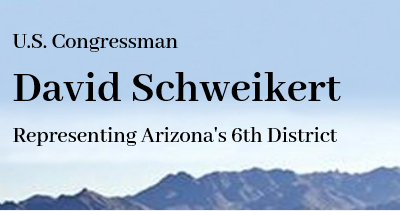WASHINGTON, D.C. – Today, Ways and Means Republicans David Schweikert (AZ-06), Brad Wenstrup (OH-02) and Carol Miller (WV-03) joined House Republican Leader Kevin McCarthy in introducing legislation as a part of the innovation portion of Republicans’ Energy Innovation Agenda. Schweikert, Wenstrup, and Miller’s legislation would significantly improve and permanently extend 45Q, the tax credit for carbon capture and sequestration, further allowing industry the ability to responsibly curb carbon emissions while creating jobs and spurring economic growth.
“I am proud to be part of this effort to promote responsible carbon removal technology, and help industry reduce our carbon footprint on a larger scale,” said Congressman Schweikert. “By improving and permanently extending 45Q, businesses will have the ability to continue adapting and expanding technological advancements to capture and sequester carbon. This legislation also makes significant strides in helping companies who are capturing carbon directly from the air better utilize the tax credit, getting us closer to scalable technology that will clean our environment and drive the economy forward.”
“Our legislation will help take more pollution out of the air as well as boost the economy without jeopardizing jobs or driving up energy costs for hardworking American families and businesses. It will help more companies enter the carbon capture market by creating certainty and predictability as well as by expanding access to the tax credit,” said Congressman Wenstrup. “By incentivizing the private sector to invest in new technology, we can continue meeting our climate goals and solidifying America’s role as the leading exporter of climate solutions. I’m proud to lead this effort with Representatives Schweikert and Miller.”
“Carbon capture is a revolutionary technology that will propel our nation’s natural resource production forward,” said Congresswoman Miller. “This legislation incentivizes further research and development into an important technology that can help solidify America as an efficient energy exporter and create more jobs here at home. As America looks to invest in innovative energy solutions, we must invest in carbon capture.”
“The 45Q tax credit is one of the main drivers for developing new carbon capture projects, and this legislation will significantly enhance the credit by not only providing long-term certainty for carbon capture projects, but also broadening the potential of carbon capture to more domestic industries,” said Rich Powell, Executive Director of ClearPath Action. “Carbon capture technology is primed for major developments, and expanding 45Q has the potential to create thousands of American jobs – it’s a win-win policy.”
Background:
Section 45Q of the tax code provides a tax credit for firms that permanently sequester carbon either underground or inside of other products. The credit is currently set to expire at the end of 2025.
This legislation would reduce carbon emissions and create jobs by:
-
Making the 45Q tax credit permanent;
-
Increasing the value of the credit from $35 to $50 per ton for carbon sequestered as part of enhanced oil and gas recovery, and for other sequestered carbon, increasing the value of the credit from $50 to $85 per ton;
-
Increasing the payout term of the credit from 12 to 20 years;
-
Reducing the minimum amount of carbon that must be sequestered for direct air capture projects to quality from 100,000 tons of carbon to 10,000 tons of carbon;
-
Reducing the minimum amount of carbon that must be sequestered for non-power manufacturing plants to qualify from 100,000 tons of carbon to 25,000 tons of carbon;
-
Reducing the minimum amount of carbon that must be sequestered for electric generating facilities to qualify from 500,000 tons of carbon to 100,000 tons of carbon;
-
Reducing the minimum amount of carbon that must be sequestered for carbon utilization to qualify from 25,000 tons of carbon to 10,000 tons of carbon.


